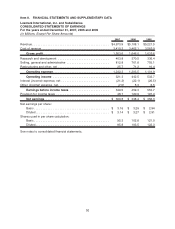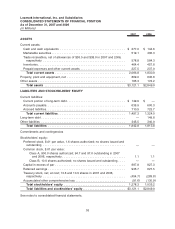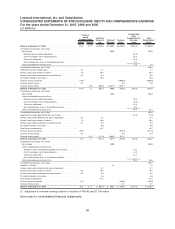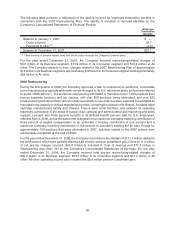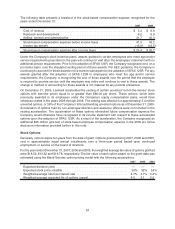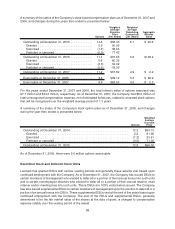Lexmark 2007 Annual Report Download - page 68
Download and view the complete annual report
Please find page 68 of the 2007 Lexmark annual report below. You can navigate through the pages in the report by either clicking on the pages listed below, or by using the keyword search tool below to find specific information within the annual report.that meets the more-likely-than-not recognition threshold is measured to determine the amount of benefit
to recognize in the financial statements. The tax position is measured at the largest amount of benefit that
is greater than 50 percent likely of being realized upon ultimate resolution.
Derivatives:
All derivatives, including foreign currency exchange contracts, are recognized in the Statements of
Financial Position at fair value. Derivatives that are not hedges must be recorded at fair value through
earnings. If a derivative is a hedge, depending on the nature of the hedge, changes in the fair value of the
derivative are either offset against the change in fair value of underlying assets or liabilities through
earnings or recognized in Accumulated other comprehensive earnings (loss) until the underlying hedged
item is recognized in earnings. Any ineffective portion of a derivative’s change in fair value is immediately
recognized in earnings. Derivatives qualifying as hedges are included in the same section of the
Consolidated Statements of Cash Flows as the underlying assets and liabilities being hedged.
Net Earnings Per Share:
Basic net earnings per share is calculated by dividing net income by the weighted average number of
shares outstanding during the reported period. The calculation of diluted net earnings per share is similar
to basic, except that the weighted average number of shares outstanding includes the additional dilution
from potential common stock such as stock options and stock under long-term incentive plans.
Accumulated Other Comprehensive (Loss) Earnings:
Accumulated other comprehensive (loss) earnings refers to revenues, expenses, gains and losses that
under accounting principles generally accepted in the U.S. are included in comprehensive earnings (loss)
but are excluded from net income as these amounts are recorded directly as an adjustment to
stockholders’ equity, net of tax. Lexmark’s Accumulated other comprehensive (loss) earnings is
composed of deferred gains and losses related to pension or other postretirement benefits, foreign
currency exchange rate adjustments, deferred gains and losses on cash flow hedges and net unrealized
gains and losses on marketable securities.
Segment Data:
Lexmark manufactures and sells a variety of printing and multifunction products and related supplies and
services and is primarily managed along Business and Consumer market segments.
Recent Accounting Pronouncements:
In July 2006, the FASB issued Interpretation No. 48, Accounting for Uncertainty in Income Taxes (“FIN 48”).
The adoption of FIN 48 did not have a material impact on the Company’s results of operations and cash
flows. Refer to Note 11 of the Notes to the Consolidated Financial Statements for discussion of the impact
of adoption on the Company’s financial position.
In September 2006, the FASB issued SFAS No. 157, Fair Value Measurements (“SFAS 157”). SFAS 157
defines fair value, establishes a framework for measuring fair value in generally accepted accounting
principles (“GAAP”) and expands disclosures about fair value measurements. SFAS 157 applies under
other accounting pronouncements that require or permit fair value measurements, the FASB having
previously concluded in those accounting pronouncements that fair value is the relevant measurement
attribute. Accordingly, SFAS 157 does not require any new fair value measurements. The provisions of
SFAS 157 should be applied prospectively as of the beginning of the fiscal year in which it is initially
applied, with limited exceptions. SFAS 157 is effective for fiscal years beginning after November 15, 2007,
and interim periods within those fiscal years, with earlier adoption permitted. In February 2008, the FASB
issued FASB Staff Position No. 157-2 (“FSP 157-2”) which defers the effective date of SFAS 157 to fiscal
years beginning after November 15, 2008 for nonfinancial assets and nonfinancial liabilities that are
62


